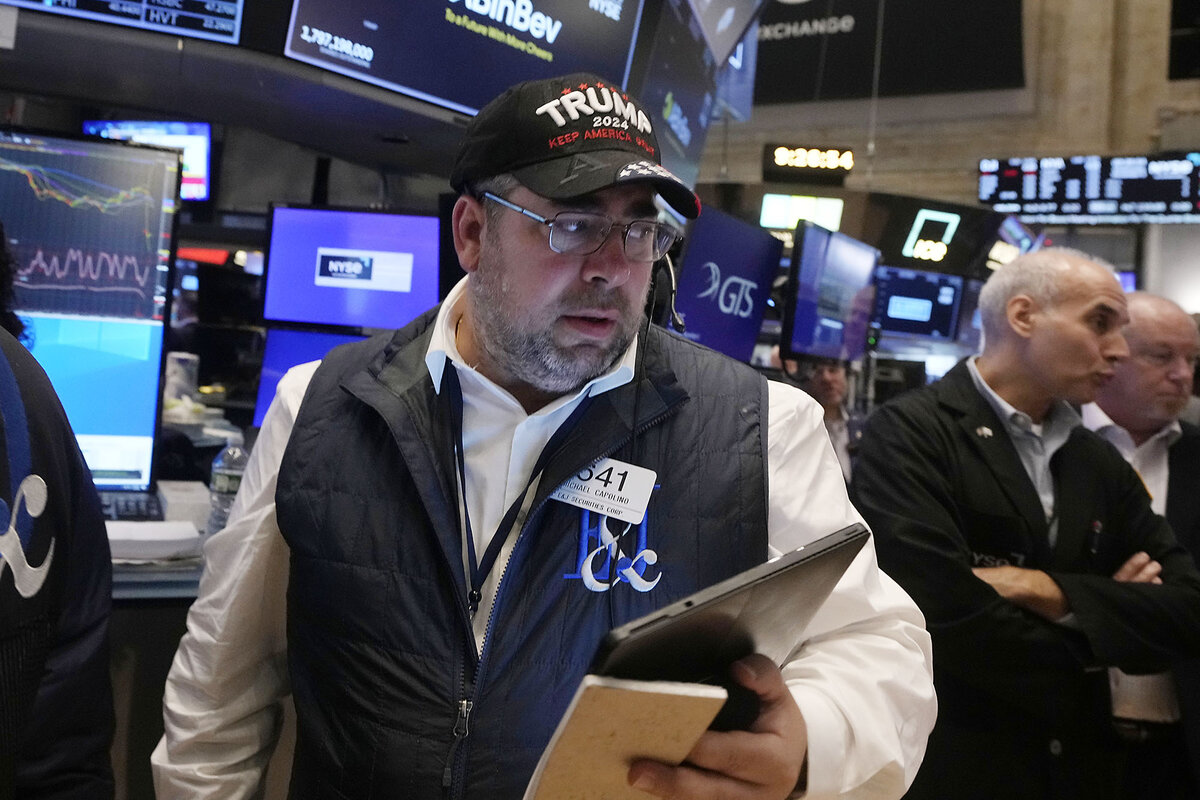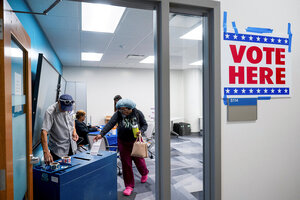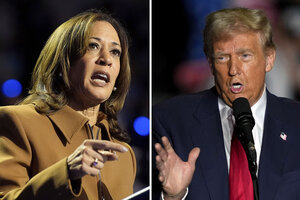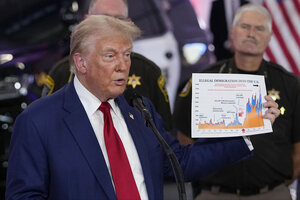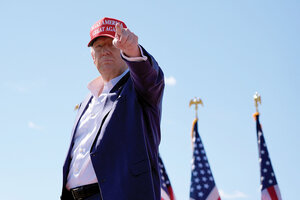Giddy with Trump promises, markets downplay deportation, tariff threats to growth
Loading...
The economic agenda of once and future President Donald Trump runs along two tracks: What he can accomplish quickly on his own and what he’ll have to work out with Congress.
Those wanting dramatic change won’t have long to wait. The most radical parts of Mr. Trump’s economic agenda – immigration and trade reform – he can complete largely on his own.
Stumping in Pennsylvania in October, he promised to “seal the border on Day 1” of his second administration. He has also promised mass deportations of unauthorized immigrants. Then the day before Election Day, Mr. Trump threatened to impose new tariffs, this time on Mexico, if it did not curb migration to the United States.
Why We Wrote This
President-elect Donald Trump’s most radical economic proposals – deportations and tariffs – may not require help from Congress. Wall Street seems more focused on his other pledges – low taxes and deregulation.
Forecasters warn that mass deportations and tariffs could slow economic growth. Yet the stock market seems buoyant so far in response to Trump’s victory.
Is Wall Street getting out ahead of its skis?
To stock traders, the big question is whether the new administration can keep these antigrowth parts of its agenda from undercutting the effects of its more traditional pro-growth policies, such as tax cuts and deregulation, which will take longer to enact.
Stock prices rise on the election outcome
On Wednesday, Wall Street cheered Mr. Trump’s decisive victory, buoyed by hopes that Republicans would extend the corporate tax cuts enacted during the first Trump administration and loosen federal rules on everything from mergers to fossil-fuel drilling and mining.
The S&P 500 index had its best post-Election Day rally in history, and on Thursday, the index and the tech-heavy NASDAQ further advanced into record territory as the Federal Reserve lowered interest rates in a widely anticipated move.
There are some good reasons for such euphoria.
When corporations pay less tax, more of their revenues become pure profit, boosting their stock prices.
Deregulation, especially after the Biden administration’s tough stances on mergers and digital forms of money known as cryptocurrencies, should allow big banks to handle more corporate dealmaking. As a result, bank stocks have soared, and bitcoin, the best-known cryptocurrency, reached a new high this week.
The bond market is more bearish
But the bond market initially sent a different signal. Bond yields spiked leading up to the election and the day after, as analysts cited worries that the collection of Trump policies will reignite inflation and force the Fed to slow or even scupper its plan to reduce interest rates gradually. Short-term yields have since eased as the Fed cut its short-term interest rate a quarter point.
The bond market appears to be taking seriously the threat of higher inflation under Mr. Trump.
One source of worry stems from Mr. Trump’s immigration plan.
He has, for example, vowed to implement “the largest deportation program in American history.” In one sense, that’s good for the remaining workforce. Fewer workers competing for the same number of jobs means higher wages. With too many jobs chasing too few workers for most of the past year, several unions were able to negotiate big pay raises.
The challenge is that higher pay boosts companies’ costs. Firms either have to swallow those costs, reducing their profits, or pass them on to their customers. This pass-through can push up inflation.
Reducing the workforce also slows growth because houses don’t get built, and crops don’t get picked if there aren’t enough workers to do the job. If Mr. Trump deports 1.3 million unauthorized laborers, it would drag down U.S. gross domestic product by 1.2% by the end of his administration, affiliated with the Peterson Institute for International Economics. If he deports 8.3 million unauthorized workers, growth would likely slow by 7.4% – potentially wiping out any growth through 2028.
Wall Street doesn’t seem overly concerned. “We would expect weaker immigration flows to be a mild, persistent headwind to labor supply and GDP growth,” economists at BofA Securities wrote in a note Wednesday. “On the flip side, we think broad deregulation, including in energy and financial services, will likely be a tailwind to growth.”
The optimistic view on tariffs
Tariffs pose another growth-slowing, inflationary threat. If Mr. Trump imposes a 10% to 20% duty on all imported goods, that will push up prices, and Americans will end up paying more for imported goods. Those price hikes could also reignite inflation.
Many Wall Street analysts are taking a more optimistic view. They say that while the new administration will act quickly to raise tariffs on China, it will use the threat of across-the-board tariffs to force other nations to lower their tariffs on American exports.
“The rest of the world – think Europe, think Mexico, Canada – will be a little more slower-path and probably transactional in nature,” Darrell Cronk, chief investment officer for wealth and investment management at Wells Fargo, said Wednesday at a teleconference for clients. “He’ll try to negotiate independent, separate deals there.”
If it’s successful, the policy could actually lead to more U.S. exports and boost growth. The danger is if it fails.
If America’s trading partners respond with tariffs of their own on U.S. goods and negotiations then stall, U.S. tariffs of 60% on China and 10% on all other countries would drag down U.S. growth by 0.8%, eliminating the equivalent of 684,000 full-time jobs, according to an estimate by the Tax Foundation. The impact would be even worse if this tariff tussle leads to a tit-for-tat trade war.
Businesses, especially importers and exporters, are moving to adjust to these new threats. And because the new administration can move quickly on both issues, it has the opportunity to adjust and limit any economic damage if its initial assumptions don’t pan out.



